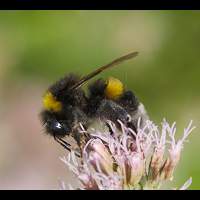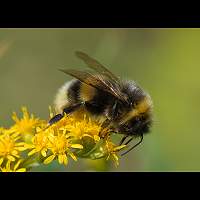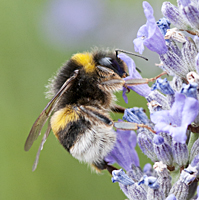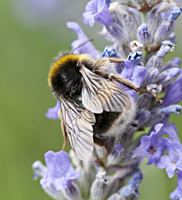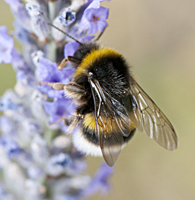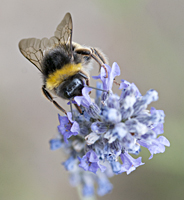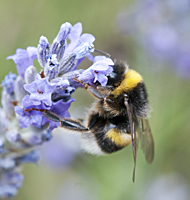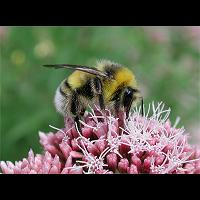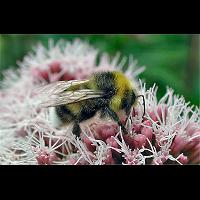[All pictures of garden wildlife on this page are thumbnails. Click on any thumbnail for a large format to be displayed.]
White-tailed Bumblebee (Bombus lucorum)
The White-tailed Bumblebee looks very similiar to the Earth Bumblebee. It is sometimes even difficult to tell the two species apart. The White-tailed Bumblebee is smaller than the Earth Bumblebee, but that is only obvious when actually putting them side by side. The complicating factor is that the two species are variable in size like, for instance, the early workers can be very small indeed. The queen is about 20 mm long and reaches a wingspan of 35 to 40 mm. Most variaties occur with the workers. The length may be anything from 9 up to 16 mm, giving them a wingspan of 20 to 33 mm. The males are less variable and hardly any smaller than those of the Earth Bumblebee. At first sight the White-tailed Bumblebee is identical to the Earth Bumblebee: a black hairy bee with a single yellow band on the thorax, just behind the head, a single yellow band on the abdomen and a white tail. The yellow colour is described as lemon yellow in the White-tailed Bumblebee and as brownish yellow in the Earth Bumblebee. However in older animals of both species the yellow may fade to greyish or whitish.
The males have much thicker yellow hairs all over resulting in a bushy appearance, as if they desperately need a haircut. The White-tailed Bumblebee is an early species, usually flying about from mid-March, but sometimes the first insects will already appear in February. The nest is constructed underground, normally in an abandoned nest of a mouse. The colonies are much smaller than those of the Earth Bumblebee and count usually 100 to 300 animals. In exceptional cases they may grow up to 400 individuals. In August the colony disperses and young queens will search for a suitable place to overwinter. The White-tailed Bumblebee is a true opportunist and is always ready to live near humans. In spring it frequents fruit trees. In summer many cultivated garden flowers will be eagerly visited. It is a very common species all over the British Isles and can be found not only in gardens and parks, but in the country side, forests and even mountains as well. In the Alps it has been found at altitudes well over 2,000 metres.
The animals in the two top pictures are probably both workers. The animals in the two bottom pictures are drones (males).
The males have much thicker yellow hairs all over resulting in a bushy appearance, as if they desperately need a haircut. The White-tailed Bumblebee is an early species, usually flying about from mid-March, but sometimes the first insects will already appear in February. The nest is constructed underground, normally in an abandoned nest of a mouse. The colonies are much smaller than those of the Earth Bumblebee and count usually 100 to 300 animals. In exceptional cases they may grow up to 400 individuals. In August the colony disperses and young queens will search for a suitable place to overwinter. The White-tailed Bumblebee is a true opportunist and is always ready to live near humans. In spring it frequents fruit trees. In summer many cultivated garden flowers will be eagerly visited. It is a very common species all over the British Isles and can be found not only in gardens and parks, but in the country side, forests and even mountains as well. In the Alps it has been found at altitudes well over 2,000 metres.
The animals in the two top pictures are probably both workers. The animals in the two bottom pictures are drones (males).

© Copyright 1998-2024 gardensafari.net (Hania Berdys)

 English / engels
English / engels  Dutch / nederlands
Dutch / nederlands